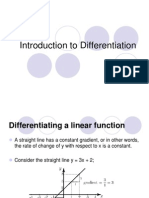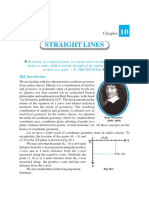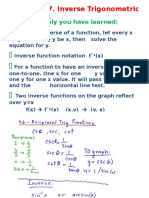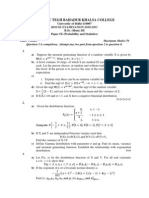Differentiation Definition: Let: y FX Ab FX
Uploaded by
Razvan Gabriel RizeaDifferentiation Definition: Let: y FX Ab FX
Uploaded by
Razvan Gabriel RizeaDifferentiation
Definition: Let ( ) y f x = be defined at any point x
in the interval , a b
| |
|
\
. The derivative at x of ( ) f x is
defined as
0
( ) ( )
( ) lim
x
dy df f x x f x
f x
x dx dx
+
if the above limit exists. ( ) f x
is a function by
itself and it is also known as the Newton quotient;
graphically, it is the slope of the tangent line of the
curve ( ) y f x = at x.
Slope of line PQ
f
x
. In the limit, if it exists,
0
lim
x
df f
x dx
=
= Slope of tangent line (a) at point P
x
Q
P
( ) f x
x
)
(a)
Example 1: If
3
( ) , 3
3
x
f x x
x
+
=
evaluate (2) f
.
0
x=2
0
0
0 0
( ) ( )
(2) lim
(2 ) (2)
lim
3 2
1 3 2
lim
3 2
3 2
1 5 1 6
lim 5 lim 6
1 1
x
x
x
x x
df f x x f x
f
x dx
f x f
x
x
x
x
x x
x x x x
| |
| |
|
|
|
\
|
| |
|
|
|
\
\
| | | |
| |
| |
| |
\ \
+
= =
+
=
+ +
+
=
+
+
= = =
Example 2: If , ( ) f x x = , show that ( ) 1 f x x = =
.
0 0
( )
( ) ( ) lim lim 1
x x
x x x
d x
f x x
x x dx
+
= = = =
Example 3: In a similar manner,
2
2 x x
| |
|
|
\
= . (Can
you prove that?)
Fortunately we do not have to evaluate the
derivatives of functions from first principles
always. We do that only for the derivatives of
some basic functions and then apply rules of
differentiation for the other cases.
Differentiation Rules
If ( ) u x and ( ) v x are differentiable functions of x
and c is a constant, then
1. The constant multiple rule
( )
d du
cu c
dx dx
=
2. The sum rule
d du dv
u v
dx dx dx
| |
|
\
=
3. The product rule
( )
d du dv
uv v u
dx dx dx
= +
4. The quotient rule
2
du dv
v u
d u
dx dx
v
dx
v
| |
|
|
\
=
If ( ) y f u = and ( ) u g x = , then ( ( )) y f g f g x = =
and
5. The chain rule
dy df df dg
du
dx du dx dg dx
= =
Example 1: Prove that
1 n n
x nx
| |
|
\
= , n is positive
integer.
Proof (by induction)
1. For 1 n= , 1 x =
. True.
2. Assume that
1 n n
x nx
| |
|
\
= is true for : n n =
3. Prove that proposition is true for : 1 n n = +
1
1
(product rule)
1
( 1)
n n n n
n n n n
n
x xx x x x x
x xnx x nx
n x
| |
| | | |
|
| |
|
\ \
\
+
= = +
= + = +
= +
QED.
Example 2: Show that
1 2
x x
| |
|
|
\
=
Apply quotient rule.
1 2
2
1 1 1 x x
x x
x
x
| |
| |
|
|
|
|
|
\
\
= = =
We will prove in the sequel that:
1
,
a a
x ax a
| |
|
\
= R
Example 3:
Show that
5 3 2 4 2
8 5 9 40 15 18
d
x x x x x x
dx
| |
|
|
\
+ = +
Constant product, sum rule, and known derivatives.
5 3 2 5 3 2
4 2
8 5 9 8 5 9
40 15 18
d
x x x x x x
dx
x x x
| | | | | | | |
| | | |
| | | |
\ \ \ \
+ = +
= +
Example 4: find the derivative of
2
2
1
1
x
y
x
+
=
Quotient rule.
2
2
( )
1
( )
1
u x
x
y
v x
x
+
= =
, then
2 2
2 2
2
2
2
2 1 2 1
1
4
1
du dv
x x x x
v u
d u
dx dx
v
dx
v
x
x
x
| | | |
| |
| |
| |
\ \
|
|
\
| |
|
|
\
| |
|
|
\
+
= =
Example 5: Find
3
2
2 3
d
x
dx
| |
|
|
\
+
Chain rule.
2
2 3 x + is a composite function of the form ( ( )) f g x
where
3 2
( ) and ( ) 2 3 f g g g x x = = + . Therefore
3
2 2
2 2
2 2
2 3 ( ( )) 3 4
3 2 3 4 12 2 3
df dg
d d
x f g x g x
dx dx dg dx
x x x x
| |
| |
|
|
|
\
\
| | | |
| |
| |
\ \
+ = = =
= + = +
Example 6: Find
2
1
1
d
dx
x
| |
|
|
|
\
+
Chain rule.
1 2
2
2
3 2
2
3
2
1
1
1
1
1 2
2
1
d d
x
dx dx
x
x
x x
x
| |
| |
|
|
|
|
\ |
\
| |
|
|
\
| |
|
|
\
= +
+
= + =
+
Derivatives of Basic Functions
In this section we will derive the derivatives of
some basic functions.
Derivatives of Trigonometric Functions
We will prove from first principles that
(sin ) cos
d
x x
dx
=
0
0
0 0
sin( ) sin
(sin ) lim
sin cos sin cos sin
lim
sin 1 cos
cos lim sin lim
x
x
x x
x x x
d
x
x dx
x x x x x
x
x x
x x
x x
+
=
+
=
=
Now, from first principles (i.e. definition of
limits):
0
sin
lim 1
x
x
x
=
(can you prove that? Its not easy!)
and from the above result and trig. properties:
0
1 cos
lim 0
x
x
x
=
(can you prove that?)
Then:
(sin ) cos
d
x x
dx
=
Using similar reasoning as for sinx
| |
|
\
we can prove
all the known trigonometric derivatives and the
results are summarised in the following table.
Derivatives of Trigonometric Functions
(sin ) cos
d
x x
dx
= (csc ) csc cot
d
x x x
dx
=
(cos ) sin
d
x x
dx
= (sec ) sec tan
d
x x x
dx
=
2
(tan ) sec
d
x x
dx
=
2
(cot ) csc
d
x x
dx
=
Example 1:
Find the derivative of
3 2
( ) 3sin 2cos f x x x = .
Sum and chain rule.
( ) ( )
( )
( ) ( )
2
2
3 3sin sin 2 2cos cos
9sin cos 4cos sin
1
9sin 4 cos sin 9sin 4 sin2
2
df
x x x x
dx
x x x x
x x x x x
| |
|
\
=
= +
= + = +
Example 2:
Find the derivative of
2 2
( ) sin f x x a
| |
|
|
\
= + .
Successive chain rule.
2 2 1 2 2 2 2 2
2 2
2 2
1
sin sin cos 2
2
cos
sin
d
x a x a x a x
dx
x x a
x a
| |
| | | | | |
|
| | |
| | |
|
\ \ \
\
| |
|
|
\
| |
|
|
\
+ = + +
+
=
+
Derivatives of Exponentials
1.
x x
e e
| |
|
\
=
Proof
2
2
1 1
1
1! 2! !
1
1! 2! !
1 2
0 1
1! 2! ! 1! ( 1)!
n
x
n
x
n n
x
x x x
e
n
x
x
x
e
n
x nx x x
n n
e
| |
| |
|
| |
| | \ \
|
\
= + + + + +
= + + + + +
= + + + + + = + + + +
=
2. ln
x x
a a a
| |
|
\
=
Proof
ln ln
x
x a x a
a e e
| |
|
|
\
= = , therefore
ln ln
ln ln
x x a x a x
a e e a a a
| |
| |
|
|
|
\
\
= = =
Derivatives of Exponentials
x x
e e
| |
|
\
= ln
x x
a a a
| |
|
\
=
Example 1: Evaluate the derivative with respect to
x of
sinx
e .
Chain rule.
)
sin sin sin
( sin cos
x x x
d
e e x e x
dx
| |
|
\
= =
Example 2: Find
2 3
cos( 1) x x d
e
dx
| |
|
|
\
+
Chain rule and product rule.
2 3 2 3
2 3
2 3
cos( 1) cos( 1)
2 3
cos( 1)
3 2 3 2
cos( 1)
3 4 3
cos( 1)
2 cos( 1) sin( 1) 3
2 cos( 1) 3 sin( 1)
x x x x
x x
x x
d d
e e x x
dx dx
e x x x x x
e x x x x
| |
| |
|
|
|
|
\
\
| |
| |
|
|
|
|
\
\
| |
|
|
\
+ +
+
+
= +
= + + +
= + +
Derivatives of Hyperbolic Functions
We can easily compute that
(sinh ) cosh
d
x x
dx
=
Indeed:
1
(sinh )
2 2
cosh
2
x x
x x
x x
d d e e d d
x e e
dx dx dx dx
e e
x
| |
| |
|
|
|
|
|
\
\
= =
+
= =
In a similar way:
Derivatives of Hyperbolic Functions
(sinh ) cosh
d
x x
dx
= (csch ) csch cot h
d
x x x
dx
=
(cosh ) sinh
d
x x
dx
= (sech ) sech tanh
d
x x x
dx
=
2
(tanh ) sech
d
x x
dx
=
2
(coth ) csch
d
x x
dx
=
Higher Order Derivatives
Recall that the derivative of a function ( ) f x is
denoted by
( ), or
df
f x
dx
If ( ) f x
is also differentiable, its derivative is
denoted by
2
2
( ), or
d f df
d
f x
dx dx
dx
| |
|
|
|
\
and it is called the second derivative of ( ) f x .
The nth derivative of ( ) f x , if it exists, is denoted
by
( )
( ), or
n
n
n
d f
f x
dx
Example: If
2
( )
x
f x x e = , then
2
2
2 2
2
3
2 2
3
2
2 4 2
4 2 6 6
x
x x
x x
df
e x x
dx
d f
d
e x x e x x
dx
dx
d f
d
e x x e x x
dx
dx
| |
|
|
\
| |
| | | |
|
| |
| |
|
\ \
\
| |
| | | |
|
| |
| |
|
\ \
\
= +
= + = + +
= + + = + +
Derivatives of Inverse Functions
Suppose
1
( ) y f x
= is an inverse of a function with
known derivative
df
dx
. Then, in order to find
dy
dx
we
proceed in general as following:
Since
1
( ) y f x
= , then ( ( )) x f y x = . Differentiating
both sides of the latter expression with respect to x
we get:
( ( )) 1 1
df dy dy df
dx d
f y x
dy dx dx dy dx dx
= = =
Substituting
1
( ) y f x
= into
df
dy
we get
dy
dx
as a
function of x.
Derivatives of Inverse Trigonometric Functions
As an example we calculate the derivative of
1
sin y x
=
Let
1
sin y x
= . Then sin x y = and 2 2 y in
order for the inverse function to exist.
Differentiating both sides of sin x y = with respect
to x, we get
1
1 cos
cos
dy dy
y
y
dx dx
= =
But
2 2
cos 1 sin 1 y y x = = . Now cos 0 y
since 2 2 y , so
2 2
cos 1 sin 1 y y x = = .
Therefore
1
2
1 1
sin
cos
1
dy
d
x
y
dx dx
x
| |
|
|
\
= = =
1 1 x
Derivatives of Inverse Trigonometric Functions
1
2
1
(sin )
1
d
x
dx
x
1
2
1
(csc )
1
d
x
dx
x x
1
2
1
(cos )
1
d
x
dx
x
1
2
1
(sec )
1
d
x
dx
x x
1
2
1
(tan )
1
d
x
dx
x
=
+
1
2
1
(cot )
1
d
x
dx
x
=
+
Derivatives of Logarithms
1.
1
log
ln
a
x
x a
| |
|
\
=
Proof
Let log
a
y x = . Then
y
x a = and differentiating both
sides of
y
x a = with respect to x, we get
1 1
1 ln
ln ln
y
y
dy dy
a a
dx dx a a x a
= = =
QED
Then you can prove easily (?)
2.
1
lnx
x
| |
|
\
=
Derivatives of Logarithms
1
log
ln
a
x
x a
| |
|
\
=
1
lnx
x
| |
|
\
=
Example 1: Show that
1
,
a a
x ax a
| |
|
\
= R
ln
ln ln
ln 1
ln
a a x
a a x a x
a x a a
x e
d d
x e e a x
dx dx
a a
e x ax
x x
| |
| |
| |
|
| |
|
\
\
\
= =
= = =
Example 2:
Show that
2
log 2 1
(2 1)ln
a
d
x
dx x a
| |
| |
|
|
|
\
\
+ =
+
Chain rule.
1
log 2 1 2 1
(2 1)ln
2
(2 1)ln
a
d d
x x
dx x a dx
x a
| |
| | | |
|
| |
|
\ \
\
+ = +
+
=
+
Example 3: Show that ln sin cot
d
x x
dx
| |
| |
|
|
|
\
\
=
Chain rule.
1 cos
ln sin sin cot
sin sin
d d x
x x x
dx x dx x
| |
| | | |
|
| |
|
\ \
\
= = =
Example 4: Show that
2
1 1
ln
1
1
d x
x dx
x
| |
|
|
|
\
+
=
Properties of logarithms and chain rule.
1
2
2
1 1
ln ln
1 1
1
ln 1 ln 1
2
1 1 1 1
2 1 1
1
d x d x
x x dx dx
d d
x x
dx dx
x x
x
| |
|
| |
| |
|
|
|
|
|
|
|
| |
\
\
|
|
\
(
| | | |
| | | |
(
| |
| |
(
| |
\ \
\ \ (
(
(
(
(
+ +
=
= +
= =
+
Derivatives of Inverse Hyperbolic Functions
We calculate the derivative of
1
sinh y x
=
Since
1
sinh y x
= , then sinh x y = . Differentiating
both sides of sinh x y = with respect to x, we get
1
1 cosh
cosh
dy dy
y
dx dx y
= =
Since
2 2
cosh sinh 1 y y = and cosh 0 y , we have
2
cosh 1 sinh y y = + , so
1
2 2
1 1 1
sinh
cosh
1 sinh 1
dy
d
x
dx dx y
y x
| |
|
|
\
= = = =
+ +
Derivatives of Inverse Hyperbolic Functions
1
2
1
(sinh )
1
d
x
dx
x
=
+
1
2
1
(csch )
1
d
x
dx
x x
=
+
1
2
1
(cosh )
1
d
x
dx
x
1
2
1
(sech )
1
d
x
dx
x x
1
2
1
(tanh )
1
d
x
dx
x
1 x <
1
2
1
(coth )
1
d
x
dx
x
1 x>
Implicit Differentiation
The functions we met so far were described by the
explicit form ( ) y f x = where y was expressed
explicitly in terms of x. This may not always be
possible and x and y may be related implicitly
through an implicit form
( , ) 0 F x y =
Then, if x is the independent variable, y becomes
the dependent variable through the expression
( , ) 0 F x y = , i.e.
2 3
5 4 0 x y xy + + + =
From an equation defining an implicit function we
can derive
dy
dx
by differentiating both sides of the
equation with respect to x, keeping in mind that y is
a function of x and therefore applying the chain
rule.
Example 1: Find
dy
dx
, if
2 3
5 4 0 x y xy + + + =
Differentiating with respect to x both sides of
2 3
5 4 0 x y xy + + + = we have
2
2
2
2 3 5 5 0
2 5
3 5 2 5
3 5
dy dy
x y y x
dx dx
dy dy x y
y x x y
dx dx
y x
| |
|
|
\
+ + + =
+
+ = =
+
As it can be seen from the previous example,
special care should be taken with terms involving
both x and y, i.e.
Product rule
2 3 3 2 2
2 3
dy
d
x y xy x y
dx dx
| |
|
|
\
= +
Quotient rule
2
2
2
2 sin cos
sin
sin
dy
x y x y
d x
dx
dx y
y
| |
|
|
|
\
=
Chain rule and Product rule
sin cos
dy
d
xy xy y x
dx dx
| |
| |
|
|
|
\
|
\
= +
Example 2: Find the slope of the tangent to curve
having equation
2 2
3 4 0 x y xy + + =
at the point
( )
, 2,4 x y
| |
|
\
= .
Solution
Differentiating implicitly with respect to x, we have
2 2 3 3 0
3 2
2 3
dy dy
x y y x
dx dx
dy y x
y x dx
+ =
=
Since
( )
, 2,4 x y
| |
|
\
= satisfies the implicit equation of
the curve, the gradient at
( )
, 2,4 x y
| |
|
\
= is
(2,4)
4
dy
dx
=
Example 3: Find
dy
dx
of
x
y x = , [0, ) x
Solution
Take logarithms and differentiate implicitly with
respect to x.
1 1
ln ln ln 1 ln
1 ln
x
dy dy
y x x x x x y
y x
dx dx
dy
x x
dx
| |
|
\
| |
|
\
= = + = +
= +
Parametric Differentiation
So far we described points
( )
, x y of curves by
giving y as a function of x either explicitly, or
implicitly. Some curves are best described when
both x and y are given in terms of another variable t
called a parameter, i.e.
( ), ( ) x x t y y t = =
We can still find
dy
dx
as follows:
dy dy dy dt
dt
dx dt dx dx dt
= =
Note that
2
2
d y
dx
IS NOT
2 2
2 2
d y dt
d x dt
. Indeed ( )
dy
g t
dx
=
and therefore
dy
dx
is given in parametric form
( ), ( )
dy
x x t g t
dx
= =
So,
2
2
d y dg dg dt
dx dx dt
dx
= =
Example 1:
Given that sin x t = and cos2 y t = , find
dy
dx
and
2
2
d y
dx
Solution
cos
2sin2
cos
2sin2
4sin cos
4sin
cos
dx
t
dy dy dt
t dt
t
dx dx dt dy
t
dt
dy
t t
t
t
dx
)
=
= =
=
= =
2
2
4sin 4sin
4sin
4cos
4
cos
d y
d d dt
t t
dx dt dx
dx
d t dt
t
t
dx dt
| | | |
| |
\ \
| |
|
\
= =
= = =
Usually parametric expressions of curves are useful
when the corresponding implicit expressions are
not describing functions. Here are some known
curves in both implicit and parametric form.
Circles
Implicit form
2 2 2
x y r + =
Parametric form
cos , sin 0,2 x r y r
(
(
= =
Ellipses
Implicit form
2
2
2 2
1
y
x
a b
+ =
Parametric form
As
2 2
sin cos 1 + = use
cos , sin 0,2 x a y b
(
(
= =
Hyperbolas
Implicit form
2
2
2 2
1
y
x
a b
=
Parametric form
As
2 2
cosh sinh 1 t t = use
( )
cosh , sinh , x a t y b t t = =
Parabolas
Implicit form
2
4 y cx =
Parametric form
( )
2
, 2 , x ct y ct t = =
Example 1:
Find the slope of the tangent to a circle (i.e.
dy
dx
)
given in either implicit, or parametric form.
Solution
Implicit form
Differentiating with respect to x the implicit form
2 2 2
x y r + = we get
2 2 0
dy dy
x
x y
y
dx dx
+ = =
Parametric form
cos , sin 0,2 x r y r
(
(
= =
cos
sin
dy dy d
r x
y
dx dx d r
= = =
You might also like
- Quality Control and Standard Operating Procedures100% (1)Quality Control and Standard Operating Procedures23 pages
- 4.2.1 Slope of The Tangent and Normal: F y y X P100% (1)4.2.1 Slope of The Tangent and Normal: F y y X P17 pages
- Matrix Algebra For Beginners, Part I Matrices, Determinants, InversesNo ratings yetMatrix Algebra For Beginners, Part I Matrices, Determinants, Inverses16 pages
- 1 SCHR Odinger's Equation: One-Dimensional, Time-Dependent VersionNo ratings yet1 SCHR Odinger's Equation: One-Dimensional, Time-Dependent Version9 pages
- Study Advice Services: Differentiation 1No ratings yetStudy Advice Services: Differentiation 123 pages
- Differentiation Explained (Little Mathematics Library) - Mir (1977)No ratings yetDifferentiation Explained (Little Mathematics Library) - Mir (1977)65 pages
- Topic 6: Differentiation: Jacques Text Book (Edition 4)No ratings yetTopic 6: Differentiation: Jacques Text Book (Edition 4)39 pages
- A Level Core Pure Maths by Michael Cook PDF100% (1)A Level Core Pure Maths by Michael Cook PDF188 pages
- Answer Solution NEET-2023 (Code-E6) FinalNo ratings yetAnswer Solution NEET-2023 (Code-E6) Final74 pages
- Cat 2007 Quantitative Questions Day Qqad ProblemsNo ratings yetCat 2007 Quantitative Questions Day Qqad Problems24 pages
- Chapter 6 (Integration Techniques) : DX X XNo ratings yetChapter 6 (Integration Techniques) : DX X X27 pages
- 2014 Calculus AB Free Response Questions (Answers and Explanations) 4No ratings yet2014 Calculus AB Free Response Questions (Answers and Explanations) 47 pages
- Undergraduate Algebra Problems and Solutions100% (1)Undergraduate Algebra Problems and Solutions106 pages
- 12 Mathematics Impq Three Dimensional Geometry 01100% (1)12 Mathematics Impq Three Dimensional Geometry 0111 pages
- Class 11 - Biology - Respiration in PlantsNo ratings yetClass 11 - Biology - Respiration in Plants13 pages
- Three Dimensional Geometry Notes For IIT JEE - pdf-24 PDFNo ratings yetThree Dimensional Geometry Notes For IIT JEE - pdf-24 PDF13 pages
- Study Material: Free Master Class SeriesNo ratings yetStudy Material: Free Master Class Series41 pages
- Important Questions For Board Exam: Trigonometry0% (1)Important Questions For Board Exam: Trigonometry3 pages
- Trignometric Identities Wk-3 Class Xith Maths (Work-Sheet)No ratings yetTrignometric Identities Wk-3 Class Xith Maths (Work-Sheet)1 page
- Differentiation of Exp, Log and Trig FunctionsNo ratings yetDifferentiation of Exp, Log and Trig Functions8 pages
- Knf1013 Week9 Differentiation Compatibility ModeNo ratings yetKnf1013 Week9 Differentiation Compatibility Mode37 pages
- Lecture 1 - Unit-I - Introduction To Decision Science & ProbabilityNo ratings yetLecture 1 - Unit-I - Introduction To Decision Science & Probability31 pages
- PRTF MGMT SDA Sample Questions20160420092753 PDFNo ratings yetPRTF MGMT SDA Sample Questions20160420092753 PDF3 pages
- B.Sc. (H) Probability and Statistics 2011-2012No ratings yetB.Sc. (H) Probability and Statistics 2011-20122 pages
- Solutions To The Exercises On Independent Component AnalysisNo ratings yetSolutions To The Exercises On Independent Component Analysis12 pages
- Assignment (Mppu 1034) Group Assignment (15%)No ratings yetAssignment (Mppu 1034) Group Assignment (15%)1 page
- Bendixson-Dulac Criterion and Reduction To Global Uniqueness in The Problem of Estimating The Number of Limit CyclesNo ratings yetBendixson-Dulac Criterion and Reduction To Global Uniqueness in The Problem of Estimating The Number of Limit Cycles9 pages
- For METTLER TOLEDO Titration Excellence Line: Selected ApplicationsNo ratings yetFor METTLER TOLEDO Titration Excellence Line: Selected Applications31 pages
- This Work Is Licensed Under The Creative Commons Attribution-Noncommercial 3.0 Singapore LicenseNo ratings yetThis Work Is Licensed Under The Creative Commons Attribution-Noncommercial 3.0 Singapore License24 pages
- Optimization Tech. V Sem-Dec._2024 (250505)No ratings yetOptimization Tech. V Sem-Dec._2024 (250505)3 pages
- Strengths and Weaknesses of Quantitative ResearchNo ratings yetStrengths and Weaknesses of Quantitative Research1 page
- Matrix Algebra For Beginners, Part I Matrices, Determinants, InversesMatrix Algebra For Beginners, Part I Matrices, Determinants, Inverses
- 1 SCHR Odinger's Equation: One-Dimensional, Time-Dependent Version1 SCHR Odinger's Equation: One-Dimensional, Time-Dependent Version
- Differentiation Explained (Little Mathematics Library) - Mir (1977)Differentiation Explained (Little Mathematics Library) - Mir (1977)
- Topic 6: Differentiation: Jacques Text Book (Edition 4)Topic 6: Differentiation: Jacques Text Book (Edition 4)
- 2014 Calculus AB Free Response Questions (Answers and Explanations) 42014 Calculus AB Free Response Questions (Answers and Explanations) 4
- Three Dimensional Geometry Notes For IIT JEE - pdf-24 PDFThree Dimensional Geometry Notes For IIT JEE - pdf-24 PDF
- Trignometric Identities Wk-3 Class Xith Maths (Work-Sheet)Trignometric Identities Wk-3 Class Xith Maths (Work-Sheet)
- Lecture 1 - Unit-I - Introduction To Decision Science & ProbabilityLecture 1 - Unit-I - Introduction To Decision Science & Probability
- Solutions To The Exercises On Independent Component AnalysisSolutions To The Exercises On Independent Component Analysis
- Bendixson-Dulac Criterion and Reduction To Global Uniqueness in The Problem of Estimating The Number of Limit CyclesBendixson-Dulac Criterion and Reduction To Global Uniqueness in The Problem of Estimating The Number of Limit Cycles
- For METTLER TOLEDO Titration Excellence Line: Selected ApplicationsFor METTLER TOLEDO Titration Excellence Line: Selected Applications
- This Work Is Licensed Under The Creative Commons Attribution-Noncommercial 3.0 Singapore LicenseThis Work Is Licensed Under The Creative Commons Attribution-Noncommercial 3.0 Singapore License

























































































